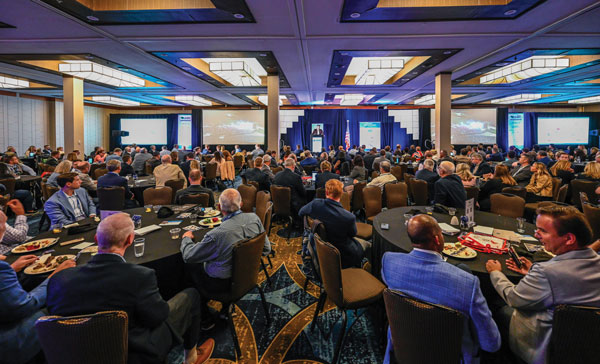Iwork for a wonderful company. One of the reasons I think of PepsiCo that way is the way it empowers women — you know, those people who make up half the world’s population.
 It’s why the company signed the White House Equal Pay Pledge in 2016. More recently, during Women’s History Month this spring, the company rolled out for the third consecutive year its “She is PepsiCo” campaign that recognizes women who work in front-line supply chain roles by featuring personalized displays on PepsiCo trucks. The campaign has boosted applications from women for these positions at PepsiCo Beverages North America by 6% since it started in 2022. For several years the company has backed a digital life skills training course with the International Youth Foundation that features scenarios with women serving in positions of authority and in non-traditional professional roles. It’s part of PepsiCo’s goal to invest $100 million by 2025 in initiatives to provide 12.5 million women and girls around the world with resources for workforce readiness and in programs that empower women.
It’s why the company signed the White House Equal Pay Pledge in 2016. More recently, during Women’s History Month this spring, the company rolled out for the third consecutive year its “She is PepsiCo” campaign that recognizes women who work in front-line supply chain roles by featuring personalized displays on PepsiCo trucks. The campaign has boosted applications from women for these positions at PepsiCo Beverages North America by 6% since it started in 2022. For several years the company has backed a digital life skills training course with the International Youth Foundation that features scenarios with women serving in positions of authority and in non-traditional professional roles. It’s part of PepsiCo’s goal to invest $100 million by 2025 in initiatives to provide 12.5 million women and girls around the world with resources for workforce readiness and in programs that empower women.
This spring, two young women were among the four recipients of a $25,000 Frito-Lay Community Builder Scholarship. One of them, Dartmouth College freshman Mehar Bhasin of Lakeville, Connecticut, co-founded the non-profit STEAM Bloom to address gender and race disparities in STEM. The organization has provided over 2,000 students free access to computer science resources.
My employer is not the only organization I’ve encountered that is leading the way in leadership by women. I guess you could say it started with my first job at my aunt’s ice cream shop. As a professional, for many years I’ve been involved with the Commercial Real Estate Women Network (CREW), whose expertise and professional camaraderie have multiplied from 1,100 members at its founding 35 years ago to more than 14,000 today in more than 80 markets, including affiliates in Mexico, the UK, France and, as of March, Ireland, recognized in this issue as one of the most promising places to invest.
IAMC is another organization not afraid to feature women front and center. Five women currently serve on our 15-member board — the same ratio PepsiCo currently has on its own 15-member board. You can find strong, knowledgeable women leading our capable IAMC staff in Atlanta and speaking from the IAMC Forum stage: Erica Orange, the futurist and executive vice president of The Future Hunters, captivated the audience at our Spring Forum in Greenville with her remarks on AI. I’m proud to see women bringing their expertise, communication skills and energy to everything from our strategic vision planning to our philanthropic endeavors, our Fun Runs at Forums and our thriving Emerging Leaders group.
Where are the wonderful women in your organization? Where are the wonderful men championing their professional development? Just like a review of your lease portfolio, gaining a clear look at the roles and perhaps unrealized potential of women on your team can reveal opportunities you didn’t know were there.
A Master Class in Industrial Real Estate
By RON STARNER
Ever wanted to take a master class in industrial real estate but thought you didn’t have the time? Well, the next best thing is attending an Industrial Asset Management Council Professional Forum, which I did April 6-10 in Greenville, South Carolina.
Jason Hickey, president of Minneapolis-based Hickey & Associates, said the best way to prepare for the practice of industrial real estate management is to be fully informed of the many challenges that confront the profession both now and in the future.

In his keynote talk to IAMC at the Hyatt Regency Hotel & Conference Center in downtown Greenville, the site selection consultant made sure that his audience of 545 registered attendees — an all-time IAMC Forum record — knew what awaited them at work.
“Most of the United States is running out of power,” he said. “If you look at the 9-year growth forecast for power demand across the U.S., you will see that a large section of the middle of the country will be facing a 4.75-gigawatt shortage by the end of this decade unless more power generation comes online between now and then.”
Every region of the U.S. needs more power, Hickey said, including the Desert Southwest. The Taiwan Semiconductor Manufacturing Co. campus in Greater Phoenix will use 1.2 GW of the 4-GW Palo Verde nuclear power plant in Arizona, he noted. As more plants come online to produce microchips, electric vehicles and the batteries they need to operate, power demand will only increase.
Plug In to These Countermeasures
To make sure your company doesn’t get caught shorthanded for energy, Hickey offered the following advice:
- Businesses need to understand their true power demands in the near term and long term.
- An additional automated manufacturing line could trigger a delay to study the impact to local circuit and larger capacity.
- Open dialogue with your utility provider about the lead time for an energy study.
- Some regions are rebuffing projects above a certain power requirement.
- Communities work with their utility partners to identify capacity and transmission gaps.
- Plan and develop strategies for future demand and risks to local systems.
Two other major challenges to industrial companies, he said, would be workforce and child care. “A recent survey showed that 77% of all employers noted that job quitting rates are still trending high,” said Hickey. “In places that are not adding replacement workers, the situation is worse. Miami is experiencing low to no growth and low unemployment. That makes it that much harder for companies to find workers.”
Child care, he noted, can cost parents $20,000 a year per child. Transportation costs can add another $20,000 a year. Factors like these require creative solutions, said Hickey.
“In Clarksville, Tennessee, they opened an 18-acre childcare facility in their industrial park with 800 child care slots,” Hickey said. “That includes 400 dedicated slots for park employees and active-duty military.”
Local opposition to industrial projects is also on the rise, he added. “Community engagement is growing in opposition to manufacturing projects,” said Hickey. “You are going to have to engage community groups early and often.”
One solution is nearshoring projects to Mexico, he said. “The Mexican population is growing, and Mexico is our No. 1 trade partner. With a growing workforce and a desire to work in factories, Mexico is a place to consider for future expansions.”
Also making Mexico more attractive is the Isthmus of Tehuantepec – a massive infrastructure project that will make movement of goods from the Gulf of Mexico to the Pacific Ocean that much quicker. (For more, see the Mexico spotlight in the March 2024 issue of Site Selection.)
Get Ready for Changing Incentives
Finally, Hickey advised corporate real estate directors to be fully aware of the changing landscape of incentives:
- CHIPS Act match funding is being required, leading states to set up closing funds for these projects.
- EDA (Economic Development Administration) and CDBG (Community Development Block Grant) funding have increased to incentivize more local projects.
- More organized workforce training programs are being set up around specific ecosystems.
- Incentives for retention of existing industry have increased, allowing for greater competition for internal investments.
- Higher wage thresholds have meant that some distribution warehouse jobs no longer qualify for certain incentive programs.
Moving from AI to Augmented Intelligence” was the title of keynote speaker Erica Orange’s presentation at the IAMC Forum in Greenville, but her talk just as easily could have been labeled: “Trust but Verify.”
With all due apologies to the late President Ronald Reagan, who often quoted that old Russian proverb when he spoke of nuclear disarmament treaties with the old Soviet Union, “trust but verify” could form the foundation of how we approach the use of artificial intelligence in the workplace.
“Question every single thing you are being told,” said Orange, executive vice president and chief operating officer of The Future Hunters, a leading futurist consulting firm based in New York. “Synthetic systems are creating in-bred data with built-in flaws.”
 AI is not the end of work. It is the end of boring work.”
AI is not the end of work. It is the end of boring work.”
— Erica Orange
This has spilled over into our world of governance, she said. “We are in a massive cycle of trust decay. We don’t know who or what to trust anymore,” she said. “We don’t know which reality is real or fake.”
The rise of AI deepfakes, artificial social media influencers and the enterprise metaverse has created a whole new set of challenges for corporate executives, said Orange. “It feels like we are freefalling into the unknown, but for every trend, there is a complementary countertrend,” she added. “For example, the rise of AI will eliminate 85 million jobs worldwide by 2025, but it will also create 97 million new ones.”
The solution will come, said Orange, when industry learns to harness AI and adapt it to intelligence augmentation. “When robots and humans work collaboratively, productivity increases 85%,” she noted. “AI is not the end of work. It is the end of boring work.”